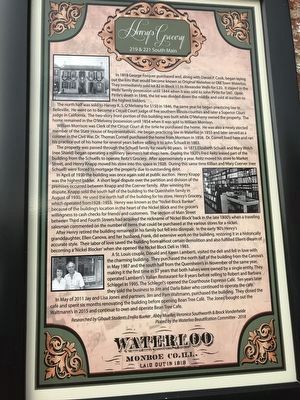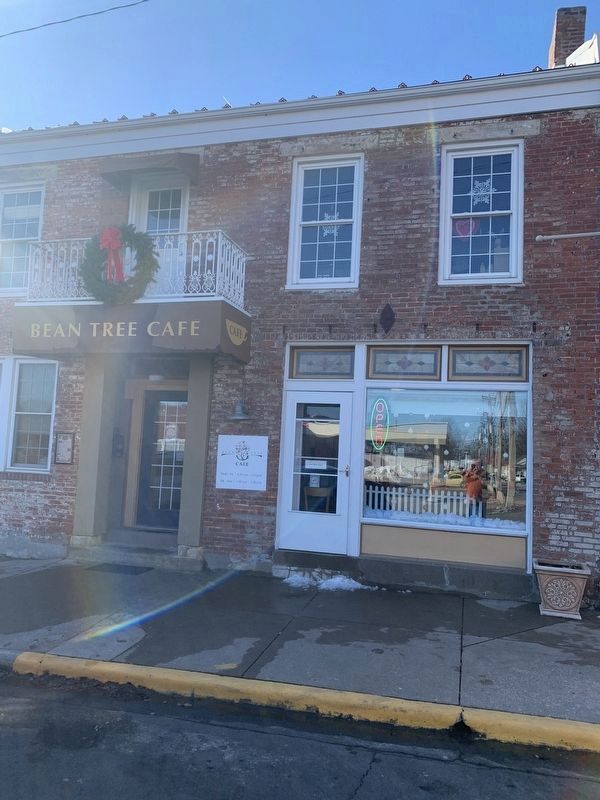Henry's Grocery
219 & 221 South Main
The north half was sold to Harvey K. S. O’Melveny for $150 in 1846, the same year he began practicing law in Belleville. He went on to become a Circuit Court judge of five southern Illinois counties and later a Superior Court judge in California. The two-story front portion of this building was built while O’Melveny owned the property. The home remained in the O’Melveny possession until 1854 when it was sold to William Morrison.
William Morrison was Clerk of the Circuit Court at the time he purchased the home. He was also a newly elected member of the State House of Representatives. He began practicing law in Waterloo in 18 55 and later served as a colonel in the Civil War. Dr. Thomas Cornell purchased the home from Morrison in 1858. Dr. Cornell lived here and ran his practice out of his home for several years before selling it to John Schuell in 1863.
The property was passed through the Schuell
family for nearly 60 years. In 1873 Elizabeth Schuell and Mary Welch (nee Shield) began operating a millinery (women’s hat shop) here. During the 1920’s Fred Reitz leased part of the building from the Schuells to operate Reitz’ Grocery. After approximately a year, Reitz moved his store to Market Street, and Henry Knapp moved his store into this space in 1928. During this same time Killian and Mary Coerver (nee Schuell) were forced to mortgage the property due to outstanding debt.In April of 1930 the building was once again sold at public auction. Henry Knapp was the highest bidder. A short legal dispute over the partition and division of the premises occurred between Knapp and the Coerver family. After winning the dispute, Knapp sold the south half of the building to the Quernheim family in August of 1930. He used the north half of the building for his store, Henry’s Grocery, which operated from 1928-1953. Henry was known as the “Nickel Block Banker” because of the building’s location in the heart of the Nickel Block and the grocer’s willingness to cash checks for friends and customers. The section of Main Street between Third and Fourth Streets had acquired the nickname of ‘Nickel Block’ back in the late 1800’s when a traveling salesman commented on the number of items that could be purchased at the various stores for a nickel.
After Henry retired, the
building remained in his family but fell into disrepair. In the early 80’s Henry’s granddaughter, Ellen Canova, and her husband, Frank, did extensive work on the building, restoring it in a historically accurate style. Their labor of love saved the building from almost certain demolition and also fulfilled Ellen’s dream of becoming a ‘Nickel Blocker’ when she opened the Nickel Block Deli in 1983.A St. Louis couple, Donald and Karen Lamberti, visited the deli and fell in love with the charming building. They purchased the north half of the building from the Canova’s in May 1987 and the south half from the Quernheim’s in November of the same year, making it the first time in 57 years that both halves were owned by a single entity. They operated Lamberti’s Italian Restaurant for 8 years before selling to Robert and Barbara Schlegel in 1995. The Schlegel’s opened the Courthouse Espresso Café. Ten years later they sold the business to Jim and Darla Baker who continued to operate the café.
In May of 2011 Jay and Lisa Jones and partners, Jim and Pam Waltmann, purchased the building. They closed the café and spent six months renovating the building before opening Bean Tree Café. The Jones’ bought out the Waltmann’s in 2015 and continue to own and operate Bean Tree Café.
Researched by Gibault Students Emilia Kueker, Abby Mueller, Veronica Southworth & Brock Vonderheide
Placed
by the Waterloo Beautification Committee - 2018Erected 2018 by Waterloo Beautification Committee.
Topics and series. This historical marker is listed in these topic lists: Architecture • Industry & Commerce. In addition, it is included in the Illinois, Waterloo Beautification Committee series list. A significant historical year for this entry is 1818.
Location. 38° 20.062′ N, 90° 9.008′ W. Marker is in Waterloo, Illinois, in Monroe County. Marker is on Main Street south of West 3rd Street, on the right when traveling south. On the same street as Monroe County Title. Touch for map. Marker is at or near this postal address: 219 South Main Street, Waterloo IL 62298, United States of America. Touch for directions.
Other nearby markers. At least 8 other markers are within walking distance of this marker. The Garretson Home (a few steps from this marker); The Advocate Building (within shouting distance of this marker); Harrisonville Telephone Company (within shouting distance of this marker); The Braun Property (within shouting distance of this marker); The Odd Fellows Building (within shouting distance of this marker); Waterloo City Hall (within shouting distance of this marker); Waterloo Municipal Band (about 300 feet away, measured in a direct line); The Wallhaus Building (about 300 feet away). Touch for a list and map of all markers in Waterloo.
Credits. This page was last revised on December 22, 2019. It was originally submitted on October 2, 2019. This page has been viewed 256 times since then and 16 times this year. Photos: 1. submitted on October 2, 2019. 2. submitted on December 22, 2019, by Thomas Smith of Waterloo, Ill. • Andrew Ruppenstein was the editor who published this page.

